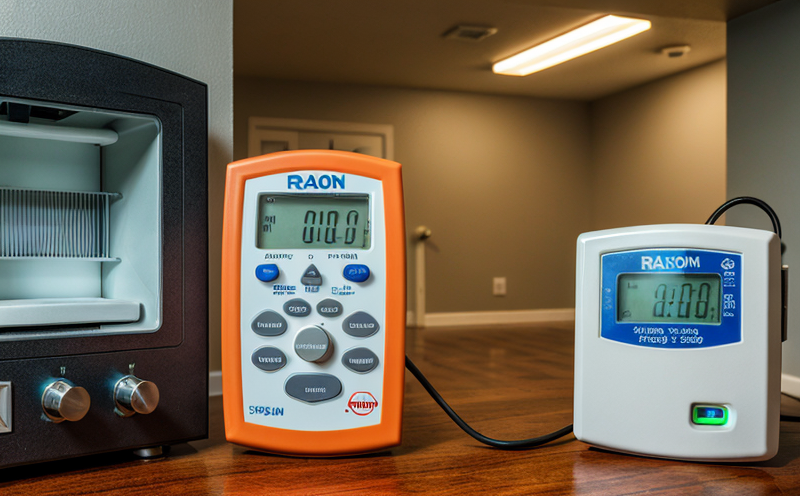ISO 11665-6 Spot Measurement of Radon Concentration in Air
The ISO 11665-6 standard specifies a method for the spot measurement of radon concentration in air using passive samplers. This technique is particularly useful for identifying short-term variations in radon levels, which can be critical for understanding localized exposure risks.
Radiation and nuclear testing, especially in residential and commercial environments, involves monitoring radon due to its potential health impacts. Radon is a colorless, odorless, and tasteless gas that forms naturally from the radioactive decay of uranium in soil and building materials. In confined spaces like homes or offices, it can accumulate to levels that pose significant health risks.
The ISO 11665-6 method allows for rapid assessment through spot measurements, which is essential for compliance with regulatory standards such as the US Environmental Protection Agency's (EPA) action level of 148 Bq/m³. The standard provides a robust framework for collecting data that can inform remediation strategies or identify areas requiring further investigation.
For quality managers and compliance officers, understanding radon concentrations is crucial for maintaining safe working environments. This method ensures accuracy in short-term exposure assessments, which is vital for the health and safety of occupants. R&D engineers often rely on spot measurements to refine models or test new materials that can mitigate radon intrusion.
The ISO 11665-6 standard emphasizes passive sampling techniques, where samplers are placed in an environment for a specified period before being collected and analyzed. This approach is particularly effective for short-term monitoring because it minimizes the need for continuous monitoring equipment, which can be resource-intensive.
For procurement professionals, selecting compliant testing methods like ISO 11665-6 ensures that they meet regulatory requirements and contribute to a safer work environment. The method's simplicity in setup and ease of use make it an ideal choice for field applications where immediate results are necessary.
The standard also provides guidelines on the selection, placement, and retrieval of samplers to ensure accurate data collection. Proper sampler positioning is critical, as radon concentrations can vary significantly within a building due to factors like ventilation patterns, temperature gradients, and structural features.
ISO 11665-6 supports the identification of high-risk areas, enabling targeted interventions such as sealing cracks in floors or walls. This proactive approach not only reduces exposure risks but also aligns with broader sustainability goals by minimizing energy consumption for ventilation systems.
The method's reliance on passive samplers ensures that it can be deployed in a wide range of environments, from single-family homes to large industrial facilities. The ease of use and portability of these samplers make them particularly suitable for field testing, where immediate results are required without the need for complex equipment.
By adhering to ISO 11665-6, laboratories can ensure consistent and reliable radon concentration measurements across various environments. This consistency is crucial for establishing baseline data that can inform long-term monitoring strategies or support compliance with international standards like the EU's Radon Action Programme.
The standard also emphasizes the importance of documentation, including details on sampler placement, sampling duration, and analysis methods. Proper record-keeping ensures traceability and reproducibility, which are essential for regulatory compliance and scientific validation.
Applied Standards
- ISO 11665-6:2019 specifies the spot measurement of radon concentration in air using passive samplers.
- This standard complements other ISO standards related to radiation and nuclear testing, ensuring a comprehensive approach to environmental monitoring.
- The method aligns with international guidelines for radon exposure, such as those provided by the World Health Organization (WHO).
Scope and Methodology
The ISO 11665-6 standard defines a method for spot measurement of radon concentration in air using passive samplers. The scope includes the selection, placement, and retrieval of these samplers, as well as the analysis procedures.
Passive sampling involves placing a sampler in an environment for a specified period before collecting it for analysis. This approach is particularly effective for short-term monitoring due to its simplicity and portability. The standard provides detailed guidelines on how to select appropriate samplers based on the specific requirements of the testing environment.
Placement of the sampler is critical, as radon concentrations can vary significantly within a building. Factors such as ventilation patterns, temperature gradients, and structural features can influence the distribution of radon. Proper placement ensures that the data collected accurately represents the conditions in the area being monitored.
The standard specifies sampling durations ranging from 24 hours to several days, depending on the specific needs of the test. Longer sampling periods generally yield more accurate results but require longer deployment times. Shorter durations are suitable for preliminary assessments or when time constraints dictate a quicker turnaround.
After the sampling period ends, the samplers are collected and transported to a laboratory for analysis. The analysis method typically involves measuring the amount of radon absorbed by the sampler, which is then used to calculate the concentration in air. This process ensures that the data obtained is reliable and comparable across different testing environments.
Environmental and Sustainability Contributions
- The ISO 11665-6 method promotes sustainable building practices by identifying radon hotspots early, allowing for targeted interventions that reduce exposure risks.
- This approach minimizes the need for extensive ventilation systems, thereby reducing energy consumption and associated carbon emissions.
- By minimizing radon intrusion, the standard contributes to healthier indoor environments, which can lead to improved productivity and reduced healthcare costs.





